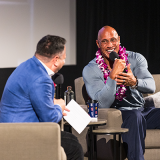
Accelerated for Interterm: The Art and Business of Web Video
January 30, 2014

Our brand new Interterm class, “The Art and Business of Web Video,” challenges students to learn the ins and outs of online video distribution,
in just four weeks
.
To give you a sense of what the class was like, I’ll tell you about some of what I saw them discuss, and next week I’ll be featuring a wrap-up of their incredibly creative final projects, which were “pitched” on the last day and are being filmed and edited right now.
It may seem overwhelming, to pack an entire semester’s worth of content into one month, but that’s not stopping our students. I could barely find a seat in the lecture room packed wall to wall with students from every discipline in the College!
In the class I observed, Professor Chindamo wrapped up the subject of online distribution, and how the history of the studio system impacts the ever-changing online video industry today.
In the past, the classic Hollywood studios owned and managed
huge
estates. From the contracted actors who represented the bulk of their expenses, to enormous and costly backlot studios, to investing in the theaters themselves — when this was possible — studios made their fortunes by wringing out every cent of their assets. They had half a century to develop their demographic audience and learn the value of marketing. They had a near monopoly on distribution. Actors and writers were locked in for
decades
.
Contrast that scenario with today, where the largest content distribution networks are lightweight, young, and increasingly niche-focused. The self-proclaimed “largest content creator network,” Fullscreen.com, has over
15,000 YouTube channels
, in every conceivable subject and for just about every demographic. Surely, this company must be owned by one of the huge studios, to have such a huge influence, I thought. But no, this privately owned company was founded in 2011!
Of course, the newer model has its own disadvantages, as well. With such a huge pool of artists, it’s very, very easy to get lost in the shuffle. Prof. Chindamo had this piece of advice for students looking to head into the business:
If you’re going to sign with a MCN, make sure all the marketing and PR promises they make by conference call, are cemented in a contract. Familiarize yourself with all the fine print, especially your requirements to feature other brands on your content, the specific news outlets and industry blogs they can get you placed with, and especially, exactly what they will do to connect you with sponsors and advertisers.
If you find yourself wondering about these trends, or if the specifics of an Amazon Studios contract have you wondering if your own work is marketable even now while you’re at school, I can’t recommend this class highly enough.
With a multibillion-dollar industry in the throes of revolution, production costs for independent filmmaking absurdly low, and entire careers ahead of them, you can imagine why these young professionals are so eager about the future!
Check back here next week to see their final projects, including the
sure-to-be-epic
Cooking With Cats
.

